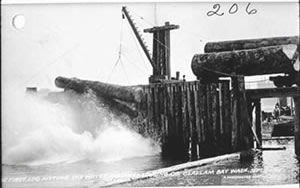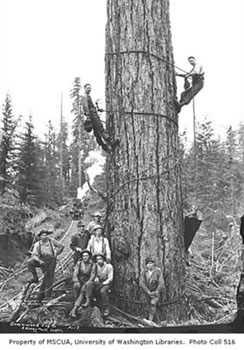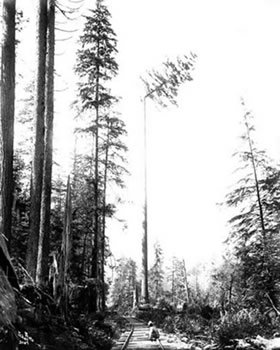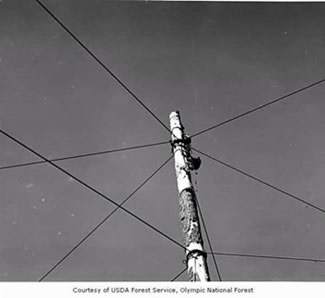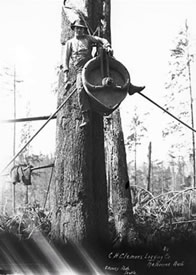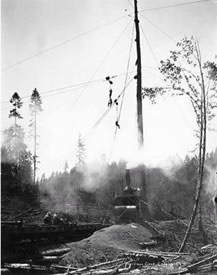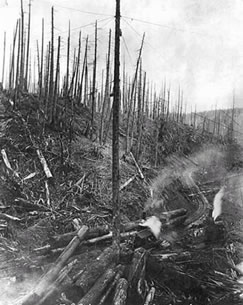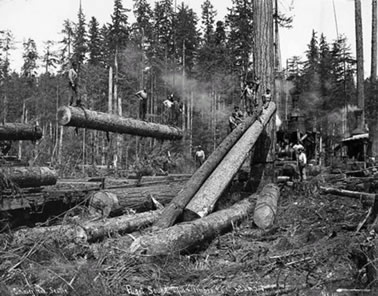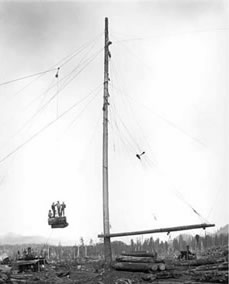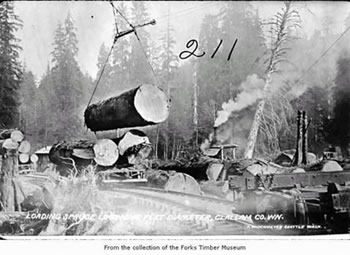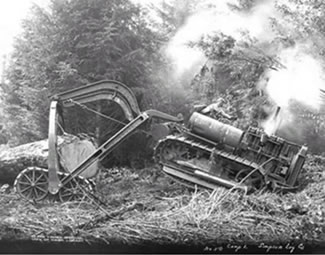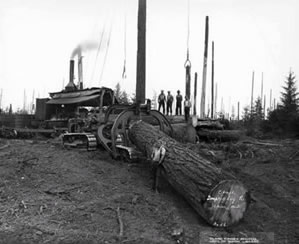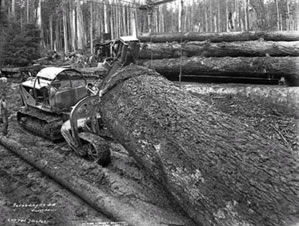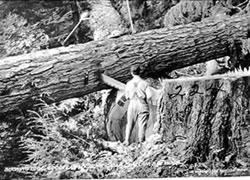 I. High-Lead Logging
I. High-Lead Logging
Introduction
Italicized words are explained in the Glossary of Logging Terms.
The tip of the Olympic Peninsula offers a case study on the intersection between technology, market demands, and resource exploitation. Although early European and American visitors had noted its dense forests, filled with trees of enormous girth and height, the region’s lack of suitable harbors—ports located within a mile of the most marketable timber—limited the timber that could be profitably harvested and moved to market—especially when more accessible timberlands were available throughout the region.
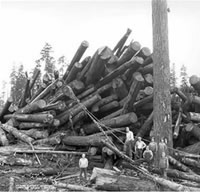 It was not until a railroad line from the mills at Port Angeles began to snake toward the small town of
Forks in the first decades of the twentieth century that lumber became a significant economic activity
on the western edge of the Olympic Peninsula. There the industry experienced a series of booms
beginning with the First World War—when the area was logged for the spruce used in aircraft construction; in the 1920s as the demand for pulp-woods rose; and, then, sustained growth from the Second World War peaking in the 1970s when a convergence of market demand and liberal federal policies opened large tracts of public lands on the peninsula to logging. Also, advances in technology, particularly high-lead yarding, the chainsaw, and the growing use of trucks made it possible to profitably log areas that in earlier years would have been bypassed.
It was not until a railroad line from the mills at Port Angeles began to snake toward the small town of
Forks in the first decades of the twentieth century that lumber became a significant economic activity
on the western edge of the Olympic Peninsula. There the industry experienced a series of booms
beginning with the First World War—when the area was logged for the spruce used in aircraft construction; in the 1920s as the demand for pulp-woods rose; and, then, sustained growth from the Second World War peaking in the 1970s when a convergence of market demand and liberal federal policies opened large tracts of public lands on the peninsula to logging. Also, advances in technology, particularly high-lead yarding, the chainsaw, and the growing use of trucks made it possible to profitably log areas that in earlier years would have been bypassed.
Figure 1 (above): Man sawing felled tree at Goodyear Logging Company work camp in or near Clallam Bay. Figure 2 (left): Crew with cold deck at loading site, camp 2, Polson Logging Company, near Hoquiam, n.d.
High-lead yarding was, perhaps, one of the biggest advancements in logging in the early part of the century. Prior to its introduction around 1910, the timber industry used groundlead yarding. That required dragging bucked logs—trees cut into manageable lengths (Figure 1)—through the forests to landings where the logs were stored until they could be transported to the mills (Figure 2). In the early years of logging on the coast of Washington, draft animals provided the muscles to move the logs to the landings. Teams of horses or, more often, oxen hauled the logs over skidroads to the landing (Figures 3 and 4). These landings were typically on a body of water where the logs could be floated and then towed to the mills in rafts. The constraints of this process typically limited logging to within about a mile of a usable waterway.
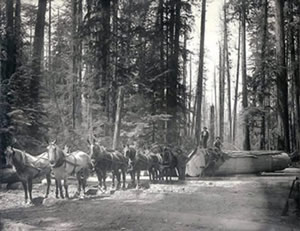 |
Figure 3 (left): Hauling logs along skidroad with a team horses, Washington, ca. 1898. Figure 4 (right): Kerry Logging Company workers with oxen pulling logs, n.d. |
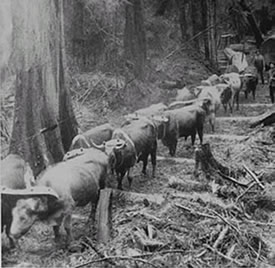 |
Background
Groundlead yarding took a giant leap forward in the 1880s when steam-driven donkeys replaced horse- and oxen-power. Now logs were dragged along the skidroads using a system of cables and blocks driven by steam donkeys. The mainline was attached to single logs or turns of them andthen wound up on a large spool powered by the donkey, pulling the timber along skidroads that were up to a mile long. The first donkeys hadonly a single spool and the mainline cable and butt rigging had to be dragged back to the cut timber 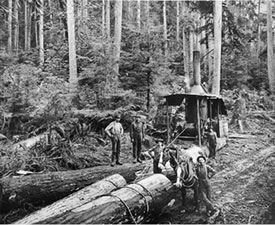 by a draft animal (Figure 5). Very quickly,however, a second spool was added for the haulback, a cable that pulled the mainline and rigging back to the worksite so it could be attached to another turn. While the mechanical power sped up the process and made it more dangerous for loggers and the rigging crew, the basic principles of skidding the timber from the worksite to the landing remained the same.
by a draft animal (Figure 5). Very quickly,however, a second spool was added for the haulback, a cable that pulled the mainline and rigging back to the worksite so it could be attached to another turn. While the mechanical power sped up the process and made it more dangerous for loggers and the rigging crew, the basic principles of skidding the timber from the worksite to the landing remained the same.
Figure 5 (right): Hall and Bishop Logging Company operations showing loggers and horses at a loading site, probably in or near Gettysburg, ca. 1905.
The introduction and extension of logging railroads, arriving on the Western Olympic Peninsula around 1900, removed the need to cut timber near large waterways (Figures 6 and 7). Narrow-gauge railroad spurs could now be run to areas remote from rivers, lakes, or the coast, opening them up to logging. Initially many of these railways terminated at a log dump along the coast where the timber could be sorted, formed into rafts, and then towed to mills (Figures 8-10). Coastal communities like Port Crescent, Gettysburg, Twin, and Pysht blossomed quickly but also, just as quickly, wilted as the newly accessible timberlands were cut down or the extension of the railroad made it possible—and affordable—to transport the logs to the mills by rail.
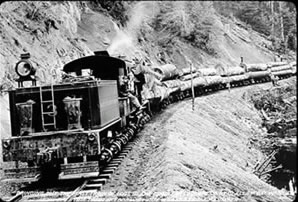 |
Figure 6 (right): Goodyear Logging Company logs transported by rail in or near Clallam Bay. Figure 7 (left): Hall and Bishop Logging Company operations at a loading site, probably in or near Gettysburg, ca. 1905. |
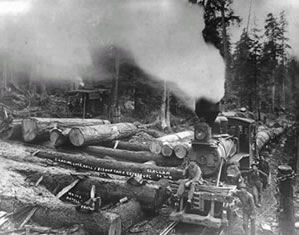 |
Figure 9 (below): Men at a log dump, probably on the Olympic Peninsula. |
|
Figure 10 (below): Goodyear Logging Company logs rafted in or near Clallam Bay. |
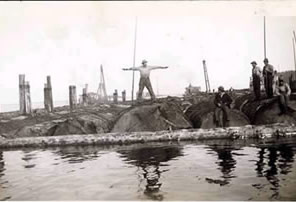 |
Figure 8 (above): Goodyear Logging Company dropping logs into holding pond in Clallam Bay.
|
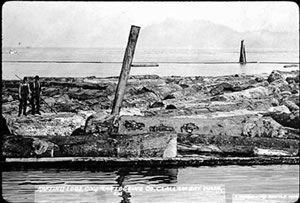 |
New Technologies
During Word War I the demand for spruce—used in aircraft frames—and the intervention of U.S. soldiers to quell labor unrest and accelerate spruce production led to the development of extensive, government-financed infrastructure improvements, including a 36-mile extension of the railroad line from Disque Junction, nineteen miles west of Port Angeles, to Lake Crescent and then to Lake Pleasant, eventually terminating at Tyee, about eight miles from Forks.The last spike on the track was driven home on November 30, 1918, nineteen days after the war ended.
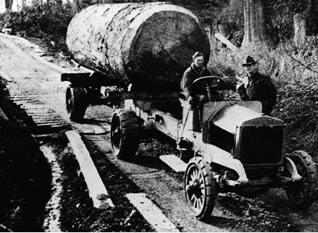 The railroad was sold to private investors in 1922 and, in 1925, incorporated within the Port Angeles and Western Railroad. Within a few years, the line was extended to Forks, serving the logging community until the railroad company abandoned it in 1954 due to lack of revenue and lawsuits stemming from the Great Forks Fire of 1951. By then trucks were carrying most of the logs to mills (Figures 11 and 12).
The railroad was sold to private investors in 1922 and, in 1925, incorporated within the Port Angeles and Western Railroad. Within a few years, the line was extended to Forks, serving the logging community until the railroad company abandoned it in 1954 due to lack of revenue and lawsuits stemming from the Great Forks Fire of 1951. By then trucks were carrying most of the logs to mills (Figures 11 and 12).
Figure 11 (left): Diamond-T log truck hauling a large log on a plank road, probably on the Olympic Peninsula.
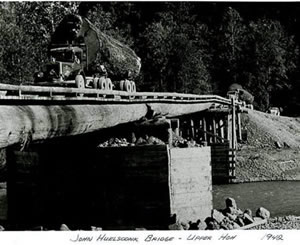 At roughly the same time railroads were starting to make their mark on the Olympic Peninsula, the timber industry was undergoing a revolution in logging methods, shifting to high-lead, or “flying,” yarding. Combining the mechanical power generated by donkey engines—mostly run on steam—
with a system of cables and blocks rigged overhead among the trees in a tract of timber,
high-lead yarding transformed logging on the peninsula. It both sped up the pace with which an area could be logged, but also made it possible to harvest trees in areas—such as ravines—that had been inaccessible to more traditional, groundlead logging. From the First World War well into the post-World War II years, high-lead logging remained a dominant pattern of timber harvesting on the Olympic Peninsula.
At roughly the same time railroads were starting to make their mark on the Olympic Peninsula, the timber industry was undergoing a revolution in logging methods, shifting to high-lead, or “flying,” yarding. Combining the mechanical power generated by donkey engines—mostly run on steam—
with a system of cables and blocks rigged overhead among the trees in a tract of timber,
high-lead yarding transformed logging on the peninsula. It both sped up the pace with which an area could be logged, but also made it possible to harvest trees in areas—such as ravines—that had been inaccessible to more traditional, groundlead logging. From the First World War well into the post-World War II years, high-lead logging remained a dominant pattern of timber harvesting on the Olympic Peninsula.
Figure 12: Log truck passing over John Huelsdonk Bridge over the Hoh River, Jefferson County
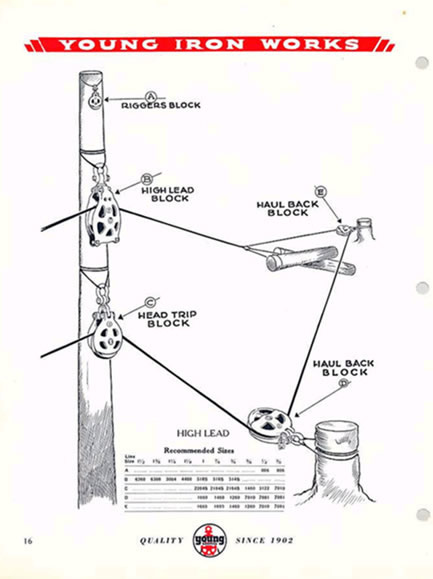
Figure 13 (left): Young Iron Works; Logging equipment, blocks, tools; Catalog No. 49.
How it Works
By the 1920s the basic technology of high-lead yarding had been worked out and refined. The operation centered on the use of one or more donkey engines running a series of cables, called “lines” or “wires” by the loggers who worked with them, rigged through blocks attached to a spar-tree. The basic set-up, as illustrated in the Young Iron Works catalog, is shown in Figure 13. (Note that the scale in this image is distorted. At the logging site the lines and blocks could extend up to a mile or more from the spar-tree.)
One of the first tasks was to locate a suitable spar-tree. This tree was meant to act as the centerpost for the network of lines that would reach out into the brush to grab the logs and pull them in to be stacked, rather like straws, in a loose pile called the cold-deck. The spar tree had to be trimmed of its branches, “topped” (the top portion of the tree, beyond the highest portion of the rigging, was cut off), and then rigged with a series of supporting guy wires, an assortment of blocks, and working lines. The guy wires kept the spar-tree upright under heavy loads while the blocks carried the lines that would drag and lift the logs as well as haul the lines back to the worksite.
Although in the early years of high-lead yarding spar-trees were of modest heights—the highest might be seventy-feet tall, about the same height as a six or seven story building or, perhaps, between two and three times taller than a telephone pole—by the 1920s it was commonplace to see logging operations using spar trees that were 150 feet tall. In several places, spar-trees were even topped at over 200 feet. What allowed the use of such mammoth trees was the development of the high-rigger. This was a logger who used climbing spikes attached to his boots and a wire-cored rope looped around the tree to climb the tree. Prior to that, loggers had built ladders or used springboards to scale the tree. Now head-riggers could walk up the side of the tree, using a short-handled axe to trim branches they went (Figure 14). When they reached a point at which the diameter of the tree narrowed to between about three or four feet, they would use the axe to top the tree. As the topped section fell away, the head rigger would hold on tightly as the tree top, released of its load, swung in arcs (Figures 15 and 16). Some head-riggers used explosives, blowing the top of a tree off with dynamite detonated with a slow fuse that was intended to give the rigger time to get to the ground and get clear.
Figure 14: High rigging crew, Greenwood Logging Company, ca. 1930. |
Figure 15: Rigger topping spar tree near railroad tracks, possibly vicinity of Index, Washington, n.d.
|
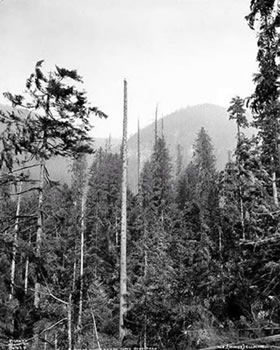
Figure 16: Rigger W. E. Illman on top of topped spar tree, 1929. |
Figure 17: Rigging tree, Olympic Peninsula.
|
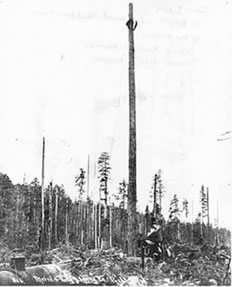
Figure 18 (right): Merrill and Ring Logging Company logging operations where men are rigging a spar tree, probably in Clallam County.
Variations
Once the tree was topped it was time to rig the trees: placing the guy wires—there were typically two sets: one attached to the top of the tree, the second about halfway up (Figure 17); “hanging” the blocks; and running the working lines through the blocks (Figure 18). It was heavy work: the mainline block on a spar-tree usually weighed hundreds of pounds. (Figure 19). It was hoisted up using a small block lashed to the almost the highest point of the tree. Once rigged, the spar-tree was ready to start moving logs (Figure 20).
|
Figure 19 (left): Logger sitting on a heavy rigging block, Clemons Logging Company, ca. 1930.
Figure 20 (right): Riggers hanging from lines attached to spar tree at loading site, Workman Creek Logging Company, probably near Elma, ca. 1926. |
|

The configurations of high-lead rigging were many and depended on the purpose of the system. One system might yard the logs from the worksite to the cold deck while another was set up to take the logs from the cold deck and load them on to train cars or trucks. Loggers working in extremely steep terrain might even rig a system that worked like an aerial tramway, swinging cut logs from one ridge to another. Several of these systems are illustrated in Young’s catalog, pages 18-28 and 32-35 and in Figures 21-25.
Figure 21: Loading site with donkey engine, spar tree, locomotive and flatcar, camp 1, Simpson Logging Company, Mason County, ca. 1924.
|
Figure 23: Crew at loading site, with two donkey engines, spartree, and logs suspended above skeleton cars, camp 8, Puget Sound Mill and Timber Company, near Twin, ca. 1922. |
Figure 24: Loading site with donkey engines, spartree, and crew raised in air, Polson Logging Company, near Hoquiam, n.d.
|
Figure 25: Logging loading site in Clallam County |
Despite the use of high-lead yarding, groundlead yarding still had a place. As the technology advanced, however, undlead yarding became the province of gasoline or diesel-powered tracked tractors that would drag the cut timbers to the landing using a variety of techniques. Three of these are illustrated in the Young Ironworks catalog (Figure 13). |
Figure 27: Logger using Caterpillar tractor and arch yarder, Simpson Logging Company, camp no. 1, ca. 1925. |
Figure 28: Logger with tractor and yarding arch, Simpson Logging Company camp no. 5, ca. 1940. |
Figure 29: Crew at loading site with donkey engine and tractor fitted with arch and winch for yarding logs, camp 1, Simpson Logging Company, Mason County, ca. 1924. |
Figure 30: Tractor fitted with winch and arch for yarding logs, Polson Logging Company, near Hoquiam, n.d. |
Conclusion
On the Olympic peninsula, as elsewhere, logging technology was never static. The timber industry always sought to develop new ways to harvest timber and move the logs to market. High-lead logging is a good example of this trend. It both sped up how quickly trees could be yarded as well as made it technologically possible to log areas—such as steep hillsides and ravines—that were inaccessible to more conventional groundlead yarding. Combined with the extension of railways it now became possible to harvest timber from large areas of the Olympic Peninsula and fuel the economic growth of the region for more than fifty years.
| Main | Section II | Section III | Section IV | Section V |
